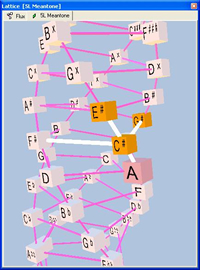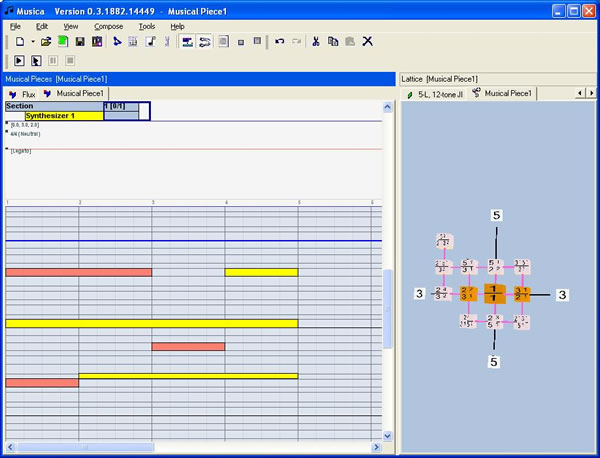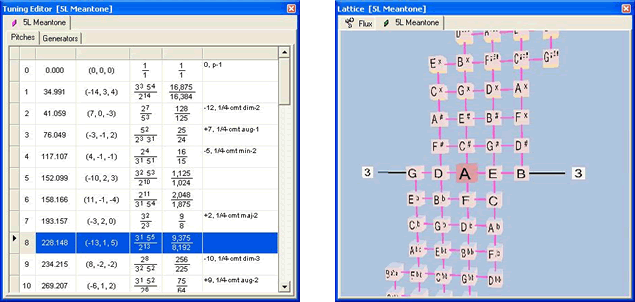Overview of Tonescape Music Composition Software
Welcome to our first article in a series of articles on the topic of Tonescape Studio 2005, Tonalsoft's music composition software application. We've been receiving numerous requests for information because there hasn't been any specific information posted yet about Tonescape. Well, here it is. I'll start out this series by explaining the fundament features incorporated in this music compost ion software application.
Microtonal Music Composition Software
First and foremost, Tonescape is a music composition software application developed specifically to support just intonation and other types of microtonal music. It has no preferred or default musical scale, which is plainly evident when you create a new musical piece. The new-piece wizard guides you through the process of adding one or more musical scales, which must be added before you can start composing. Once created, our music composition software application will present you with two views of the Tonescape piece:

- The first view is the composition editor and is called the "Composer". The Composer enables you to view and edit you piece using one of the available music notations. In the first release of Tonescape Studio, both Pitch Height notation and a variety of staff notations are available.
- The second view is the 3-dimensional lattice diagram, which is simply called the "Lattice". The Lattice is unique to Tonescape and provides a visually intuitive tool for understanding the harmonic relationships between the pitches/ tones in a musical scale (or tuning). What's both so unique and so powerful about the Lattice View is how intuitive it makes the art of composing. After a brief period of "noodling" a Tonescape lattice, you'll be ready to compose a serious piece with that musical scale. Lattices help you understanding the underlying principles of harmony. With the lattice, you can creatively explore new approaches to music that weren't obvious when doing things the old way through rote memorization.
Tonescape Lattice showing the Meantone Tuning, circa mid-1700's. A C#-major triad is shown playing.
The really powerful aspect of this microtonal music composition software is the dynamic integration between the Lattice and Composer. What you see in the Lattice can be applied directly to your musical piece and while you work with the Composer, the lattice updates to display the harmonic implications. The lattice is such a practical tool that it also allows you to work more creatively and intuitively in the 12-tone musical scale than ever before.
Music Notation Editor
Music notation is one of the more complex and unresolved areas associated with microtonal and just intonation music because (a) there is no commonly agreed upon standard (b) many music notations are not capable of efficiently dealing with a wide variety of microtonal and just intonation tunings. Tonalsoft's music composition software works well with this state of affairs by handling all musical notations in the form of downloadable, software plug-ins. From the ground up, Tonescape has been designed to help you work in this heterogeneous environment. You can even compose a single musical piece with multiple notations at the same time. As you update your piece in one panel, updates are reflected in other notation panels. Tonescape will even support editing of a musical piece with both horizontally and vertically based musical notations.
With the release of Tonescape Studio 2005, both pitch-height and staff notation will be supported. Pitch-height notation is the sibling of the more familiar piano-roll notation. The primary difference is that the height or thickness of notes in pitch-height are variable and indicative of the sonic-size of the interval between notes. The following image gives you the flavor of using pitch-height notation:

Musical piece employing 5-limit just intonation and being displayed using pitch-height notation on Tonescape's Composer panel. To the right, one sees that the 12-tone lattice's selection is synchronized with that of the left panel.
Tonescape Studio 2005 also supports multiple variations of staff notation. Each variation can employ very distinct techniques for depicting the pitches of notes. Staff notation variants may use custom staffs, staff-groups (e.g., the grand staff is a staff group), clefs, and accidentals. With our music composition software application's initial release, we'll support the traditional staff notation (i.e., Pythagorean or Meantone-based), the 72-edo quartertone staff, the HEWM staff, Ben Johnston's staff, and staff-notation for percussion instruments as well.
Microtonal Music Theory
Microtonal and just intonation musical tuning theorists can also find a number of useful tools in Tonescape's integrated workspace. Not only does our music composition software application enable the composer to compose using thousands of different musical tunings, microtonal theorists can rapidly create and sample new musical tunings using Tonescape's Tuning Editor, which is also integrated with the Lattice to provide dynamic visual feedback. As you make modifications to a musical scale/ tuning in the Tuning Editor, those changes are displayed on the accompanying lattice.
Musical scales or tunings are based on the concept of adding instances of generators to an otherwise empty musical scale. In the sense of a musical tuning, a generator is something that increases the pitch of a note by a specified amount. The increase in pitch is what the generator produces. In our music composition software, each note or pitch in a musical scale is defined as a combination of zero or more pre-defined generators. If you didn't follow the details, the real point is that Tonescape provides an extremely powerful mechanism for defining musical scales. Almost any conceivable tuning can be created and used for composing, such as:
- Multi-dimensional just intonation systems
- Multi-dimensional open and closed temperaments
- Hybrid tunings such as Werckmeister and other Well Temperaments
- Non-traditional tunings such as 88-cet and Lucy Tuning

Images of both the Tuning Editor and accompanying Tuning Lattice. The Tuning Editor is displaying the pitches that belong to a 5-limit Meantone tuning. The lattice shows those same Meantone pitches, which are notated using traditional letter notation.
MIDI Support
Support for MIDI synthesizers and MIDI controllers is central to Tonalsoft's strategy for making the performance and production of microtonal music a practical reality. For microtonal and just intonation music synthesis, Tonalsoft's music composition software provides real-time playback, which can be used while composing or during a live performance. Tonescape uses the standard communications ports such as a game port, MIDI port, old-style serial ports, parallel ports, and USB ports for controller MIDI synthesizers. Moreover, Tonalsoft's music composition software package can be used for setting the tuning tables on MIDI synthesizers that support MTS, the MIDI Tuning Specification.
Tonescape also accepts input from MIDI controllers through those same computer ports. Use your favorite MIDI controller to record microtonal music. While you play, your notation of choice will be updated to keep your musical notation synchronized with you.
Additionally, Tonalsoft's music composition software application enables you to export your microtonal music pieces in the form of MIDI files. Exported MIDI files are Type 2 files and will provide an accurate rendition of your microtonal or just intonation piece. The major advantage in exporting your musical pieces is that they can be re-played with a large variety of devices and software packages. The primary disadvantage is that MIDI export files will NOT contain all of the tuning and other data contained within a native Tonescape file.
